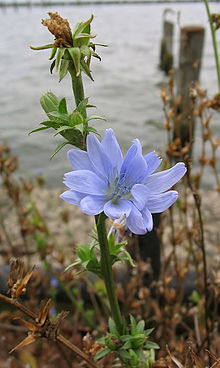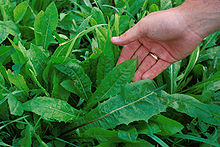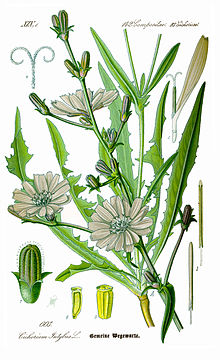- Chicory
-
This article is about the cultivated vegetable called chicon. For the Worldcons named Chicon, see Worldcon.
Common Chicory 
Common chicory (Cichorium intybus) Scientific classification Kingdom: Plantae (unranked): Angiosperms (unranked): Eudicots (unranked): Asterids Order: Asterales Family: Asteraceae Tribe: Cichorieae Genus: Cichorium Species: C. intybus Binomial name Cichorium intybus
L.Common chicory, Cichorium intybus,[1] is a somewhat woody, perennial herbaceous plant usually with bright blue flowers, rarely white or pink. Various varieties are cultivated for salad leaves, chicons (blanched buds), or for roots (var. sativum), which are baked, ground, and used as a coffee substitute and additive. It is also grown as a forage crop for livestock.[2] It lives as a wild plant on roadsides in its native Europe, and in North America and Australia, where it has become naturalized.
"Chicory" is also the common name in the United States for curly endive (Cichorium endivia); these two closely related species are often confused.[3]
Contents
Names
Common chicory is also known as blue sailors, succory, and coffeeweed. It is also called cornflower, although that name is more commonly applied to Centaurea cyanus. Common names for varieties of var. foliosum include endive, radicchio, Belgian endive, French endive, red endive, sugarloaf or witloof.
Description
When flowering, chicory has a tough, grooved, and more or less hairy stem, from 30 to 100 centimetres (10 to 40 in) tall.
The leaves are stalked, lanceolate and unlobed.
The flower heads are 2 to 4 centimetres (0.79 to 1.6 in) wide, and usually bright blue, rarely white or pink. There are two rows of involucral bracts; the inner are longer and erect, the outer are shorter and spreading. It flowers from July until October.
The achenes have no pappus (feathery hairs), but do have toothed scales on top.[4]
Leaf chicory
Wild
Wild chicory leaves are usually bitter. Their bitterness is appreciated in certain cuisines, such as in the Liguria and Puglia regions of Italy and also in Catalonia (Spain), in Greece and in Turkey.[5] In Ligurian cuisine the wild chicory leaves are an ingredient of preboggion and in Greek cuisine of horta; in the Puglian region wild chicory leaves are combined with fava bean puree in the traditional local dish Fave e Cicorie Selvatiche.[6]
By cooking and discarding the water the bitterness is reduced, after which the chicory leaves may be sauteed with garlic, anchovies and other ingredients. In this form the resulting greens might be combined with pasta[7] or accompany meat dishes.[8]
Cultivated
Chicory may be cultivated for its leaves, usually eaten raw as salad leaves. Cultivated chicory is generally divided into three types, of which there are many varieties:[9]
- Radicchio usually has variegated red or red and green leaves. Some only refer to the white-veined red leaved type as radicchio. Also known as red endive and red chicory. It has a bitter and spicy taste, which mellows when it is grilled or roasted. It can also be used to add color and zest to salads.
- Sugarloaf looks rather like cos lettuce, with tightly packed leaves.
- Belgian endive is also known as French endive, witlof in Dutch or witloof in Belgian Dutch, witloof in the United States[citation needed], chicory in the UK, as witlof in Australia, endive in France, and chicon in parts of northern France and in Wallonia. It has a small head of cream-coloured, bitter leaves. It is grown completely underground or indoors in the absence of sunlight in order to prevent the leaves from turning green and opening up (etiolation). The plant has to be kept just below the soil surface as it grows, only showing the very tip of the leaves. It is often sold wrapped in blue paper to protect it from light and so preserve its pale colour and delicate flavour. The smooth, creamy white leaves may be served stuffed, baked, boiled, cut and cooked in a milk sauce, or simply cut raw. The tender leaves are slightly bitter; the whiter the leaf, the less bitter the taste. The harder inner part of the stem at the bottom of the head should be cut out before cooking to prevent bitterness. Belgium exports chicon/witloof to over 40 different countries. The technique for growing blanched endives was accidentally discovered in the 1850s in Schaerbeek, Belgium.[10] Endive is cultivated for culinary use by cutting the leaves from the growing plant, then keeping the living stem and root in a dark place. A new bud develops but without sunlight it is white and lacks the bitterness of the sun-exposed foliage. Today France is the largest producer of endive.
 Inflorescences of a blue-flowered form. Note the two rows of bracts
Inflorescences of a blue-flowered form. Note the two rows of bracts
Although leaf chicory is often called "endive", true endive (Cichorium endivia) is a different species in the genus.
Root chicory
Root chicory (Cichorium intybus var. sativum) has been in cultivation in Europe as a coffee substitute. The roots are baked, ground, and used as a coffee substitute and additive, especially in the Mediterranean region (where the plant is native), although its use as a coffee additive is also very popular in India, parts of Southeast Asia, South Africa and southern United States, particularly in New Orleans. It has also been popular as a coffee substitute in poorer economic areas, and has gained wider popularity during economic crises such as the Great Depression in the 1930s. Chicory, with sugar beet and rye was used as an ingredient of the East German Mischkaffee (mixed coffee), introduced during the "coffee crisis" of 1976-79.
Some beer brewers use roasted chicory to add flavor to their stouts.
Around 1970 it was found that the root contains up to 20% inulin, a polysaccharide similar to starch. Inulin is mainly found in the plant family Asteraceae as a storage carbohydrate (for example Jerusalem artichoke, dahlia, etc.). It is used as a sweetener in the food industry with a sweetening power 1⁄10 that of sucrose[11] and is sometimes added to yogurts as a prebiotic. Inulin can be converted to fructose and glucose through hydrolysis. Inulin is also gaining popularity as a source of soluble dietary fiber and functional food.[12]
Chicory root extract is a dietary supplement or food additive produced by mixing dried, ground chicory root with water, and removing the in soluble fraction by filtration and centrifugation. Other methods may be used to remove pigments and sugars. Fresh chicory root typically contains, by dry weight, 68% inulin, 14% sucrose, 5% cellulose, 6% protein, 4% ash, and 3% other compounds. Dried chicory root extract contains, by weight, approximately 98% inulin and 2% other compounds.[13] Fresh chicory root may contain between 13 and 23% inulin, by total weight.[14]
Agents responsible for bitterness
The bitter substances are primarily the two sesquiterpene lactones Lactucin and Lactucopicrin. Other ingredients are Aesculetin, Aesculin, Cichoriin, Umbelliferone, Scopoletin and 6.7-Dihydrocoumarin and further sesquiterpene lactones and their glycosides.[15]
Medicinal use
Root chicory contains volatile oils similar to those found in plants in the related genus Tanacetum which includes Tansy, and is similarly effective at eliminating intestinal worms. All parts of the plant contain these volatile oils, with the majority of the toxic components concentrated in the plant's root.[16]
Chicory is well known for its toxicity to internal parasites. Studies indicate that ingestion of chicory by farm animals results in reduction of worm burdens,[17][18][19] which has prompted its widespread use as a forage supplement. Only a few major companies are active in research, development, and production of chicory varieties and selections, most in New Zealand.
Chicory (especially the flower) was used as a treatment in Germany, and is recorded in many books as an ancient German treatment for everyday ailments. It is variously used as a tonic and as a treatment for gallstones, gastro-enteritis, sinus problems and cuts and bruises. (Howard M. 1987). Chicory contains inulin,[20] which may help humans with weight loss, constipation, improving bowel function, and general health.[21] In rats, it may increase calcium absorption and bone mineral density.[20]
Chicory has demonstrated antihepatotoxic potential in animal studies.[22][23][24][25]
Forage
Chicory is highly digestible for ruminants and has a low fiber concentration.[26] Chicory roots are an "excellent substitute for oats" for horses due to their protein and fat content.[27] Chicory contains a low quantity of reduced tannins[26] that may increase protein utilization efficiency in ruminants.[28] Some tannins reduce intestinal parasites.[29][30][31][32] Large quantities of tannins bind with and precipitate proteins, resulting in low digestibility and nutrient reduction.[29]
Although chicory might have originated in France, Italy, and India,[33] much development of chicory for use with livestock has taken place in New Zealand.[34]
Forage chicory varieties
- Puna (Grasslands Puna) – One of the most popular forage varieties, developed in New Zealand. It is well adapted to different climates, being grown from Alberta, Canada, to New Mexico and Florida. It is resistant to bolting, which leads to high nutrient levels in the leaves in spring. It also has high resistance to grazing.
- Forage Feast – A variety from France used for human consumption and also for wildlife plots.[clarification needed] It is very cold-hardy, and due to use for human consumption it is lower in tannins than other forage varieties.
- Choice – Choice has been bred for high winter and early-spring growth activity, and lower amounts of lactucin and lactone, which are believed to taint milk. It is also use for seeding deer wildlife plots.
- Oasis – Bred for increased lactone rates for the forage industry, and for higher resistance to fungal diseases like Sclerotinia.[clarification needed]
- Puna II – More winter-active than most other varieties, which leads to greater persistence and longevity.
- Grouse – A New Zealand variety used as a planting companion for forage brassicas. More prone to early flowering than other varieties, with higher crowns more susceptible to overbrowsing.
- Six Point – A United States variety, very similar to Puna.
History
The chicory plant is one of the earliest cited in recorded literature. Horace mentions it in reference to his own diet, which he describes as very simple: "Me pascunt olivae, me cichorea, me malvae" ("As for me, olives, endives, and mallows provide sustenance").[35] Lord Monboddo describes the plant in 1779[36] as the "chicoree", which the French cultivate it as a pot herb. In Napoleonic Era France chicory frequently appeared as either an adulterant in coffee, or a coffee substitute.[37] Chicory was also adopted as a coffee substitute by Confederate soldiers during the American Civil War, and has become common in the United States. In the United Kingdom during the Second World War where Camp Coffee, a coffee and chicory essence, has been on sale since 1885.
The cultivated chicory plant has a history reaching back to ancient Egyptian time. Medieval monks raised the plants and when coffee was introduced to Europe, the Dutch thought that chicory made a lively addition to the bean drink.
In the United States chicory root has long been used as a substitute for coffee in prisons.[38] By the 1840s, after New York, the port of New Orleans was the second largest importer of coffee.[37] Louisianans began to add chicory root to their coffee when Union naval blockades during the American Civil War cut off the port of New Orleans creating a long-standing tradition.[37]
A common meal in Rome, puntarelle, is made with chicory sprouts.[39] The Food and Agriculture Organization (FAO) reports that Chicory is a native plant of western Asia, North Africa, and Europe.[1]
Chicory is also mentioned in certain sericulture (silk-growing) texts. It is said that the primary caretaker of the silkworms, the "silkworm mother" should not eat or even touch it.[citation needed]
The chicory flower is often seen as inspiration for the Romantic concept of the Blue Flower (e. g. in German language 'Blauwarte' ≈ 'blue lookout by the wayside'). It was also believed to be able to open locked doors, according to European folklore.[40]
References
- ^ a b http://ecocrop.fao.org/ecocrop/srv/en/cropView?id=694
- ^ Blair, Robert (2011-04-30). Nutrition and Feeding of Organic Cattle. ISBN 9781845937584. http://books.google.com/?id=B0bXX_grAwYC&pg=PA68&dq=Chicory+forage+livestock#v=onepage&q=Chicory%20forage%20livestock&f=false.
- ^ http://plantanswers.tamu.edu/vegetables/endive.html
- ^ Rose, Francis (1981). The Wild Flower Key. Frederick Warne & Co. pp. 390–391. ISBN 0-7232-2419-6.
- ^ Tijen İnaltong - Wild Herbs of Turkey
- ^ Recepta - Fave e Cicorie Selvatiche
- ^ Wild Chicory Spaghetti
- ^ Jaume Fàbrega, El gust d'un poble: els plats més famosos de la cuina catalana. Llomillo fregit amb xicoires
- ^ http://www.gardenzone.info/crops/index.php?crop=chicory
- ^ http://www.foodmuseum.com/endive.html
- ^ http://www.functionalingredientsmag.com/article/Formulations/using-inulin-and-oligofructose-with-high-intensity-sweeteners.aspx
- ^ Madrigal L. Sangronis E. "Inulin and derivates as key ingredients in functional foods. [Review]" [Spanish] Archivos Latinoamericanos de Nutricion. 57(4):387-96, 2007 Dec.
- ^ Kim, Meehye; Shin, HK (1996). "The Water-Soluble Extract of Chicory Reduces Glucose uptake from the Perfused Jejunum in Rats". J. Nutr. 126 (9): 2236–2242. PMID 8814212. http://jn.nutrition.org/cgi/reprint/126/9/2236.pdf. Retrieved 2008-08-20.
- ^ Wilson, Robert; S; Y (2004). "Chicory Root Yield and Carbohydrate Composition is Influenced by Cultivar Selection, Planting, and Harvest Date". Crop Sci. 44 (3): 748–752. doi:10.2135/cropsci2004.0748. http://crop.scijournals.org/cgi/content/abstract/44/3/748. Retrieved 2008-08-20.
- ^ Harsh Pal Bais, GA Ravishankar (2001) Cichorium intybus L – cultivation, processing, utility, value addition and biotechnology, with an emphasis on current status and future prospects. Journal of the Science of Food and Agriculture, 81, 467-484 (online)
- ^ Edible and Medicinal Plants of the West, Gregory L. Tilford, ISBN 0-87842-359-1
- ^ "Individual administration of three tanniferous forage plants to lambs artificially infected with Haemonchus contortus and Cooperia curticei". Vet Parasitol. 146 (1–2): 123–34. 2007-05-15. doi:10.1016/j.vetpar.2007.01.009. PMID 17336459.
- ^ "The use of chicory for parasite control in organic ewes and their lambs". Parasitology. 134 (Pt 2): 299–307. February 2007. doi:10.1017/S0031182006001363. PMID 17032469.
- ^ "The effect of chicory ( Cichorium intybus ) and sulla ( Hedysarum coronarium ) on larval development and mucosal cell responses of growing lambs challenged with Teladorsagia circumcincta". Parasitology. 132 (Pt 3): 419–26. March 2006. doi:10.1017/S0031182005009194. PMID 16332288.
- ^ a b Roberfroid, MB; Cumps, J; Devogelaer, JP (2002). "Dietary chicory inulin increases whole-body bone mineral density in growing male rats". The Journal of nutrition 132 (12): 3599–602. PMID 12468594.
- ^ http://www.webmd.com/vitamins-supplements/ingredientmono-1048-INULIN.aspx?activeIngredientId=1048&activeIngredientName=INULIN
- ^ Tabassum N., Qazi M.A., Shah A., Shah M.Y. "Curative potential of Kashni (Cichorium intybus Linn.) extract against carbon tetrachloride induced hepatocellular damage in rats" Pharmacologyonline 2010 2 (971-978)
- ^ Hassan HA. Yousef MI. "Ameliorating effect of chicory (Cichorium intybus L.)-supplemented diet against nitrosamine precursors-induced liver injury and oxidative stress in male rats."Food & Chemical Toxicology. 48(8-9):2163-9, 2010 Aug-Sep.
- ^ Ahmed B. Khan S. Masood MH. Siddique AH."Anti-hepatotoxic activity of cichotyboside, a sesquiterpene glycoside from the seeds of Cichorium intybus." Journal of Asian Natural Products Research. 10(3-4):223-31, 2008 Mar-Apr.
- ^ L. Zafar R. Mujahid Ali S."Anti-hepatotoxic effects of root and root callus extracts of Cichorium intybus" Journal of Ethnopharmacology. 63(3):227-31, 1998 Dec.
- ^ a b Agronomy, American Society of (2005-10-25). Advances in agronomy. ISBN 9780120007868. http://books.google.com/?id=jla_sZtQPi0C&pg=PA209&lpg=PA209&dq=chicory+tannins+nitrogen#v=onepage&q=chicory%20tannins%20nitrogen&f=false.
- ^ Bureau Of Foreign And Domestic Commerce, United States; Bureau Of Manufactures, United States (1915). Commerce reports. http://books.google.com/?id=TisoAAAAYAAJ&pg=PA74&dq=chicory+protein#v=onepage&q=chicory%20protein&f=false.
- ^ http://www.qdma.com/what-we-do/articles/food-plotshabitat/chicory/me
- ^ a b http://www.smallstock.info/info/feedhealth/tannins.htm
- ^ Schreurs NM. Molan AL. Lopez-Villalobos N. Barry TN. McNabb WC."Effects of grazing undrenched weaner deer on chicory or perennial ryegrass/white clover pasture on the viability of gastrointestinal nematodes and lungworms." Veterinary Record. 151(12):348-53, 2002 Sep 21.
- ^ Kidane A. Houdijk JG. Athanasiadou S. Tolkamp BJ. Kyriazakis I."Effects of maternal protein nutrition and subsequent grazing on chicory (Cichorium intybus) on parasitism and performance of lambs." Journal of Animal Science. 88(4):1513-21, 2010 Apr.
- ^ Effects of grazing undrenched weaner deer on chicory or perennial ryegrass/white clover pasture on the viability of gastrointestinal nematodes and lungworms. Schreurs NM. Molan AL. Lopez-Villalobos N. Barry TN. McNabb WC. Veterinary Record. 151(12):348-53, 2002 Sep 21.
- ^ http://www.qdma.com/what-we-do/articles/food-plotshabitat/chicory/
- ^ http://www.ruralliving.co.nz/cms/special_feature/pasture_management/2011/03/making_good_use_of_chicory.php
- ^ Horace, Odes 31, ver 15, ca 30 BC
- ^ Letter from Monboddo to John Hope, 29 April 1779; reprinted by William Knight 1900 ISBN 1-85506-207-0
- ^ a b c Guas, David; Raquel Pelzel (2009). DamGood Sweet: Desserts to Satisfy Your Sweet Tooth, New Orleans Style. Newtown, Connecticut: Taunton Press. pp. 60–64. ISBN 978-1-60085-118-6.
- ^ (a) Delaney, John H. "New York (State). Dept. of Efficiency and Economy Annual Report". Albany New York, 1915, p. 673. Accessed via Google Books.
(b) "Prison Talk" website; Kentucky section: http://www.prisontalk.com/forums/archive/index.php/t-173368.html. - ^ http://www.rome.info/food/
- ^ Howard, Michael. Traditional Folk Remedies (Century, 1987), p.120.
External links
- Chicory Coffee - How Does it Taste?
- ITIS 36762
- Chicory photo and description
- Dogfish Head's Chicory Stout
- History of Belgian Endive
- Species of chicory and endive
- Edibility of Chicory: Edible parts and identification of wild Chicory.
- Chicory, from Nature Manitoba
Categories:- Food additives
- Dietary supplements
- Prebiotics
- Asteraceae genera
- Leaf vegetables
- Spices
- Coffee substitutes
- Flora of Michigan
Wikimedia Foundation. 2010.



